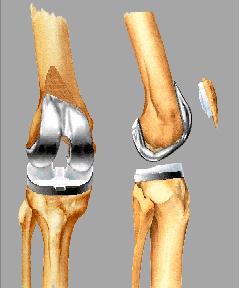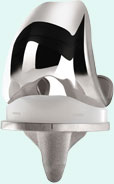What is a total knee replacement?
 Total Knee ReplacementA total knee replacement consists of three pieces. These are made of rugged polyethylene (high density plastic) and alloy metals. These pieces resurface the three bones that comprise the knee joint (the femur, tibia, and patella). The femoral component (the end of the thighbone) is made of alloy metal (cobalt chrome). The tibial component (the top of the shin bone) has a metal tray with a snap-in plastic insert with a groove in the femoral components. These components are usually held in place with cement. This cement is actually a polymer that serves as a grout and is not an adhesive. Occasionally we will press-fit the components. This relies on the ingrowth of the patient’s own bone for fixation and is used based upon the patient’s age and bone quality.
Total Knee ReplacementA total knee replacement consists of three pieces. These are made of rugged polyethylene (high density plastic) and alloy metals. These pieces resurface the three bones that comprise the knee joint (the femur, tibia, and patella). The femoral component (the end of the thighbone) is made of alloy metal (cobalt chrome). The tibial component (the top of the shin bone) has a metal tray with a snap-in plastic insert with a groove in the femoral components. These components are usually held in place with cement. This cement is actually a polymer that serves as a grout and is not an adhesive. Occasionally we will press-fit the components. This relies on the ingrowth of the patient’s own bone for fixation and is used based upon the patient’s age and bone quality.
How long do they last?
Design changes have occurred in recent years and current prostheses have been improved in an effort to yield better function and longevity. Since the prostheses now being used are of newer designs we do not exactly know how long they will last. Most studies have found that at 10 years 90% of all knee replacements are functioning well. Another study has found that, at 18 years, 94% of knee replacements are still functioning. A well-implanted prosthesis, in a compliant patient, usually lasts for many years. Strenuous use and obesity have the potential to shorten the life of the implant. It should be emphasized that total knee replacements are not done to allow the patients to return to unlimited activities. Fitness may be maintained by “low impact” sports such as swimming or bicycling. Golfing and bowling are usually possible, and even moderate skiing in some individuals. Jogging is not recommended. Doubles tennis is preferred to singles.
What is a rotating platform total knee replacement?
 The rotating knee replacement (mobile bearing) implants not only swing back and forth (like a hinge), but the knee can also rotate inwards and outwards (a twisting motion). The hope is that by acting more like a normal knee joint, the rotating knee replacements will have less stresses on the implant than traditional knee replacement implants. With less stress on the implant, the plastic part of the knee replacement may wear out less over time. If the implant wears out more slowly, the implant would hopefully last longer.
The rotating knee replacement (mobile bearing) implants not only swing back and forth (like a hinge), but the knee can also rotate inwards and outwards (a twisting motion). The hope is that by acting more like a normal knee joint, the rotating knee replacements will have less stresses on the implant than traditional knee replacement implants. With less stress on the implant, the plastic part of the knee replacement may wear out less over time. If the implant wears out more slowly, the implant would hopefully last longer.
How is the rotating platform different?
The main difference between a Rotating Platform knee replacement implant and a traditional (fixed-bearing) implant lies in the design of the tibial (shin), component of the implant. With a Rotating Platform knee implant, the plastic spacer can rotate. Because it can rotate with the part of the implant that affixes to the thighbone, the contact between the two can be more evenly distributed. This can reduce the stress and wear on the implant. In a fixed-bearing implant, the shinbone is topped with a flat metal piece that securely holds the plastic spacer, also called a bearing, securely in place.
What are the benefits of a rotating platform?
 Some people may think it’s better to delay surgery until they’re older because they believe that knee implants don’t last. Rotating Platform knees are designed for patients who want their knee replacement to accommodate normal movement while significantly minimizing implant wear (as compared to traditional knees). Minimizing implant wear can help your knee replacement last longer. Rotating Platform knees have a 30-year history of clinical success and a high rate of patient satisfaction. In fact, patients studied in a DePuy Orthopaedics, Inc. multi-surgeon study reported a 97% satisfaction rate with their implants five years after surgery. Rotating Platform knees have also continued to evolve over the years to meet patients’ needs. In 2006, DePuy Orthopaedics introduced the only FDA-approved Rotating Platform high flexion (deep knee bending) implant.
Some people may think it’s better to delay surgery until they’re older because they believe that knee implants don’t last. Rotating Platform knees are designed for patients who want their knee replacement to accommodate normal movement while significantly minimizing implant wear (as compared to traditional knees). Minimizing implant wear can help your knee replacement last longer. Rotating Platform knees have a 30-year history of clinical success and a high rate of patient satisfaction. In fact, patients studied in a DePuy Orthopaedics, Inc. multi-surgeon study reported a 97% satisfaction rate with their implants five years after surgery. Rotating Platform knees have also continued to evolve over the years to meet patients’ needs. In 2006, DePuy Orthopaedics introduced the only FDA-approved Rotating Platform high flexion (deep knee bending) implant.
What is the hospital stay like?
You will be admitted the day of surgery and remain hospitalized for approximately 3-4 days. Immediately after your knee replacement you may place your full weight on your new knee. We will begin your therapy the day of your surgery and emphasize walking, regaining your range of motion, and strengthening exercises. The quicker we can get you home, the better off you will be.
Your pain is controlled with injections and later by pain pills. Your discomfort should significantly decrease by the third day and only require pain pills before performing therapy. After all major orthopedic surgeries, the patient is at risk of developing a blood clot. Occasionally, a blood clot can break free from their location in the leg veins and travel via the blood stream to the lungs, causing serious complications and even death. We can significantly decrease this risk by placing you on a blood thinner for approximately 2 weeks.
What are potential complications?
The most common complications after a knee replacement are infection and blood clots. We can lower the risk of infection to less than 1% by using special operative suites, meticulous operative technique, and antibiotics before surgery and for 48 hours after surgery. If an infection does occur, another surgery may be required to “wash out” the infection from the knee. Occasionally the knee prostheses must be removed to allow eradication of infection. Usually a new prosthesis can be implanted after the infection is cleared.
We significantly lower the risk of blood clots by placing you on a blood thinner for approximately 2 weeks. If you develop significant leg swelling or shortness of breath, you need to seek immediate medical attention to evaluate for a blood clot or embolus.
Other complications include: dislocation of the components, premature loosening, fractures around the components, damage to nerves or arteries during surgery, and anesthesia risks.
We emphasize that these risks are rare and feel that the potential benefits from a knee replacement far outweigh the potential risks. We take significant precautions to lower these risks.
What should I expect after surgery?
- Discharge from the hospital can be expected on the third post-operative day.
- The staples are usually removed from the skin in 10 to 14 days.
- You may shower or immerse the knee in water two weeks from the time of surgery.
- You may swim, use a Jacuzzi, or whirlpool in 2-3 weeks.
- Driving an automobile is not recommended until you are one-month post surgery so that the control of the extremity is regained. Patients who have surgery on the left knee can sometimes drive sooner.
- Crutches or a walker are utilized for approximately 4-6 weeks.
- Maximum recovery is attained in 3-6 months. You may notice that your knee may swell after activity for up to one year after surgery.
